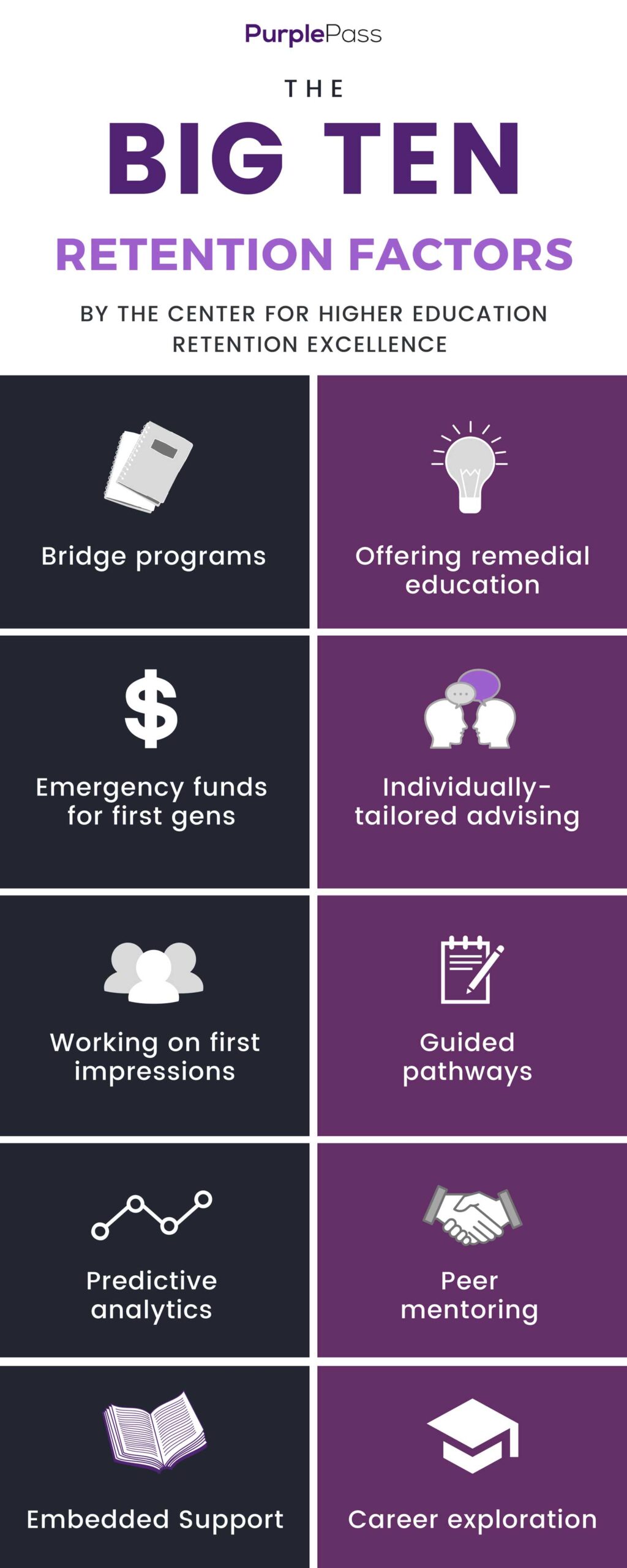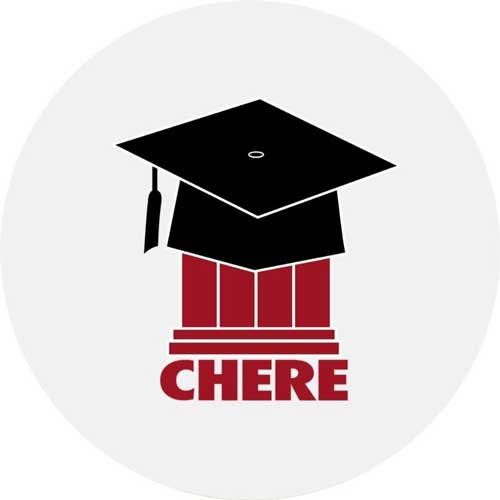10 Retention Factors and High-Impact Student Practices
Gleaned from Multiple Sources and compiled by David Johnston, 2014-2020
Retention is recognized as the persistence of students from enrollment to graduation, meaning overall graduation rates and how long someone remains in a program. In this article, the Center for Higher Education Retention Excellence (CHERE) will walk us through their retention practices and tips for improving rates in classes and now online during the pandemic.
CHERE, created in 2012 and based in Connecticut, is a program of the Hartford Consortium
for Higher Education, a 25 year-old not-for-profit agency focused primarily on college access.

High Impact Retention Practices:
Easy to describe, hard to do well, especially during a pandemic
The “big picture” for retention is a continuum that links K-12 education to higher education, and that recognizes “risk factors” inherent to under-represented children and youth that are often not eliminated when this youth enroll in some type of higher education.
Efforts to address this achievement gap –sometimes called an “opportunity gap” – need to be viewed on a continuum requiring collaboration among public and private sector partners, and where no one partner (e.g., state government, public schools, public colleges and universities, private higher ed institutions, community-based organizations) can dictate strategies.
Many of the elements of a long-term, “multi-sector,” comprehensive “retention/persistence plan,” an overall coordinating mechanism notwithstanding, could include the following elements.
Importance of leadership
All of these factors require longer-range vision at the top of organizations – the willingness of leaders to evaluate themselves (e.g., colleges, state government, community-based agencies, foundations) for innovation opportunities, and the willingness to work across organizational boundaries to fashion collaborative arrangements that decrease control but increase the potential for progress.
Without bold leadership, both within and outside organizations, most of not these “success factors” will not happen or if pursued, not go beyond token activity.
Funding for innovation
Budgets at both the K-12 and higher education levels are stretched to the maximum today, all of them as they struggle to survive the pandemic, and many colleges and universities as they confront the shorter-range struggle to offer quality education on-line during the pandemic, and the longer-range “demographic challenge” of constantly declining numbers of traditional age students.
Higher educational institutions, especially those without large endowments, must find creative ways to fund innovations, including identifying new sources of students, and to build or enhance partnerships with the philanthropic world to find funding for innovation. Many of the strategies and programs outlined below got their start with outside philanthropic funding from both major foundations and private giving.
The “Big Ten” Retention Factors

Drawn from David Johnston’s Summary of “Retention Practices Gleaned from Multiple Sources”
1. Bridge programs: Several types, for different ages; but any bridge program exposing pre-college students to college life can greatly ease the transition to college.
2. New Approaches to developmental (remedial) education: Several schools and states have developed new approaches to remedial education, allowing students to go right into credit courses, and with “supplemental instruction,” helping both traditional aged and adult learners get up to speed.
3. Emergency funding: Many underrepresented and first generation students arrive on campus with little or no “extra” money, financial aid notwithstanding. Some are hungry; some cannot afford books or transportation. An “emergency fund,” and a food pantry, can make a huge difference.
4. Predictive analytics: Retention/persistence needs to be anticipated for the most challenged students, with a solid data system that can lead to thoughtful “intrusive advising” from day one ongoing.
5. First day, first week, first month, first year: First impressions, first experiences, first contacts with
other freshmen and older students, can launch new students in good or not so good ways.
6. Guided pathways: For many first semester students, especially at community colleges, they are easily overwhelmed by course and major choices. More schools are using guided pathways (e.g., “meta majors”) to simplify this initial challenge.
7. Intrusive advising: Effective advising, especially at staff-limited community colleges, is hard to do, requiring presidential leadership and enough funding to hire more advisers and counselors.
8. Peer mentoring: An increasing number of colleges are able to train and provide peer mentors to help freshmen. Mentors can provide both academic and social/emotional support. Freshmen who get involved quickly in a campus activity (e.g., club, sports team) will sometimes find a mentor with interests similar to theirs and thus a key incentive to persist.
9. Embedded Support: freshmen take regular intro courses supplemented by additional, intensive work outside regular class time, all for credit – replacing traditional “developmental” education – also known as “Supplemental Instruction.”
10. Career exploration: “Contextual” or “experiential” education is what many of today’s students need – both traditional-age and “adult learners” -- pointing to real jobs and real careers and hence a purpose for higher education. While liberal arts education should still be valued for its inherent ability to teach students how “to live,” a very important albeit amorphous skill, “generation X” students, and adult learners trying to improve their lives, need to see a path to a stronger financial future as soon as they begin college.
Read more about the "Big Ten" here.
The pandemic and retention
Has everything we thought we knew about higher education and especially the factors that influence retention (as outlined here) transformed? It’s not clear yet; but we will know more after most schools resume some semblance of “college life” in late August 2020.
|
Resources for students during COVID With Purplepass, schools can manage |
Retention will surely suffer, in the aggregate, as many students decide either not to go back to their campuses and work only online, and some (e.g., 10 percent) decide not to go back or start at all, choosing to in effect take a “gap year” to work or if they have means, to travel if and when that is possible again.
For students who are trying to begin or continue their higher education, use these retention factors and strategies outlined below for high-impact retention practices:
1. Constant communications: Don’t let them (students) out of your “sight!” Overlapping use of:
- Texting
- Phone calls
-
Letters (yes, actual, mailed letters, perhaps from a “peer mentor, professor or counselor)
2. Intrusive advising
- Divide it up among counselors, advisors, faculty, administrators and peer mentors
- Learn what they need, what they want, what they fear
-
Recruit and use peer mentors – there’s nothing like one student to another to build confidence.
3. Cut students some slack re. grades, but not too much re. content
Much was learned from the spring online experience, but many students did not get online or did not do well with it.
The learning curve is still steep, and this is not the time to come down too hard, or students will be lost or at least discouraged. Once engaged, the difficulty can be accumulated with the students’ knowledge.
4. Nurturing a “growth mindset”
Taking this key strategy into the online world through a series of structured, and sometimes fun, online activities, individual and via logical groups
5. Attention to the Mental Health of Students (and Staff)
Stress, anxiety and loneliness are common; and those teachers, counselors, and advisors in touch with students need to listen carefully for “distress signals,” practice their “coaching language,” and know when to refer students to counseling help. The same goes for themselves and other adult staff.
6. Incentives/Rewards
Budget challenges notwithstanding, why not try “bribes” if some funding could be found, as one way to keep connected to students – thus:
- $ for attending all classes; $ for active participation – controversial but likely effective
- Gift cards
-
Extra academic credit
7. Create a “Student Advisory Board” to advise campus staff on “Pandemic management.”
The following are some key retention and success factors
1. Creation of a “promise” program that provides (“promises”) guaranteed college scholarships to underrepresented and first-generation, lower-income students who meet GPA and attendance criteria.
Addition of an “investment” incentive, requiring students’ families, and students who graduate, to “give back” to the program financially, as a way to sustain funding beyond the philanthropic support the program receives. Hartford Promise has also created a program, “The Nearlies,” that works with Hartford high school students whose record does not quite qualify them for a Promise scholarship, to help them get to that level.
Note: Hartford’s and New Haven’s Promise Programs have raised substantial philanthropic funding to serve as the asset base for their commitments to high school students. Providence Promise also receives some philanthropic funding but has built its 2019-created program on an “investment model,” whereby
Promise students’ families pay into the asset base on a sliding fee scale, and Promise students who graduate from higher ed. must commit to a “payback,” again on a sliding fee scale. (pvdpromise.org)
2. Financial Aid: Careful, individually tailored help to complete the FAFSA, explore scholarship possibilities, and meet the financial aid requirements of each student’s target schools.
Except for high schools in affluent communities, high school guidance counselors are often ill-equipped and/or just too busy to be an expert in the FAFSA, or have time to devote to every student’s case, when their case loads are typically in the hundreds.
3. Bridge programs for incoming freshmen, or younger, ideally on campus -- that combine skill building, assessment, deficit reduction, and fun.
An overnight stay, or a multi-week, on-campus summer experience goes a long way toward increasing first generation comfort level.
4. Dual enrollment/”Early College” – exposing high school students to college-level work and instructors through partnerships between a campus and one or more feeder high schools.
This is a good way for motivated, carefully counseled high school students to gain college credits (besides or instead of via AP courses) and can be a good chance for “cross-sector” relationships when taught by college faculty or high school faculty certified by nearby college faculty.
5. Assessment of “college readiness” in multiple ways, including less emphasis on SAT, ACT and/or Accuplacer, and more on high school GPA, attendance, behavior, and sometimes the earned reputation of the high school. Documenting “achievement gaps,” typically accumulated throughout the K-12 years, is a negative but necessary part of such assessment.
(Note: Connecticut Public Act 12-40 mandates such multiple assessments, but community colleges use only the Accuplacer to make placement decisions – convenient but for many students, superficial, in our opinion.)
6. Introduction to financial literacy: enlisting college and other financial aid specialists, including campus-based peer mentors, to visit high schools to help students understand financial aid; but a second important part of “financial literacy” is an education in practical life skills (e.g., banking, credit management, insurance, housing options and costs, car maintenance, and more.
High schools have life skills courses, but it is usually not a requirement for all students. It should be. In some communities, community-based organizations are helping their program students complete the FAFSA and teaching broader life skills.
7. Embedded Support: Many incoming students cannot handle credit courses, but if given “supplemental instruction,” attending regular credit classes – usually in English and math -- supplemented by 1-2 “lab classes” per week taught by faculty and/or TAs and/or peer mentors, such students are more likely to pass the credit course.
8. Mentors: Ideally, every “challenged” student in K-12, but especially in high school would benefit from a skilled mentor if there was an ample supply, based more or less on the Career Beginnings model practiced at the Hartford Consortium for Higher Education for many years – trained mentors backed up by HCHE staff who begin working with selected Hartford students at the beginning of 12th grade and continue to support them through their first two years of college (“seamless counseling”).
9. Emphasis on reading and writing:
Reading is a critical factor in preventing significant achievement gaps by the time students graduate high school. A good mentor, and ideally parents and family, should encourage reading and writing.
10. Managing social media:
Young people, and some older people, love their communications technology, especially smartphones; but their prevalence and addictive power can inhibit learning, especially reading and writing. Parents and teachers of K-12 students need to set limits, and students in both K-12 settings and in higher education need to be taught to balance their use with in-depth reading and writing, and to learn how to live without them occasionally.
11. Identifying “fake news”:
Since 2016, and before, print and on-line media have been accused of “fake news..” Although this is sometimes just a label for news, accurate or not, with which someone does not agree, usually for ideological or political reasons. However, the 2016 presidential campaign showed the size and severity of the “fake news” issue.
Fortunately, an increasing number of high school and colleges have developed courses to help students sort out “fact from fiction,” and there are not software programs that can teach students and teachers to do this. (For example, the News Literacy Project offers a “virtual classroom,” Checkology -- $3.50-5 per student – that does just that.)
12. Gap Year
An idea, a retention strategy now coming into its own – an opportunity for students, perhaps burned out by high school and the pressure to get into college, to engage in something meaningful. An increasing number of colleges and universities are helping admitted students pursue gap years, and some have developed scholarship funds to open this to lower-income students – and a proven retention factor. This opportunity should be open to students of all backgrounds.
You can read CHERE's entire guide on high impact retention practices and find more resources here. Their complete guide spans the college continuum of k-12 through college.
|
Purplepass for education Host events, class registration, lectures, |
CHERE helps colleges and universities develop, improve and scale programs that address the urgent issues we face today in higher education. Their experience in planning and organizing conferences and convenings (25 since its start-up) gives them access to and experience with best practices that can aid their most urgent work, especially with their core population of challenged students.








